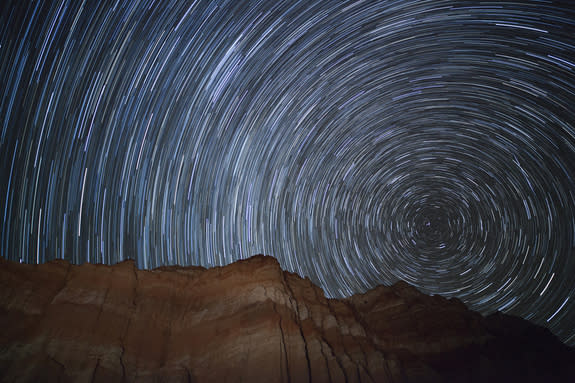Orionid Meteor Shower, Leftovers from Halley’s Comet, Set to Peak This Weekend
Posted on October 18, 2013 by END TIME HEADLINES

Cosmic litter from Halley’s Comet is set to pepper the night sky in a meteor shower before dawn this weekend and early next week. The Orionid meteor shower can best be described as a lesser version of the famous Perseid meteor shower of August. The October shower is scheduled to reach its maximum before sunrise on Monday morning (Oct. 21). The meteors are known as “Orionids” because they seem to fan out from a region to the north of Orion’s second brightest star, the ruddy hued Betelgeuse. Currently, Orion appears ahead of Earth in the planet’s journey around the sun. The constellation does not completely risen above the eastern horizon until after 11:30 p.m. local daylight time. [Photos: Orionid Meteor Shower of 2012] At its best during the predawn hours around 5 a.m. EDT (0900 GMT) — Orion will be highest in the sky toward the south — the Orionids typically produce around 20 to 25 meteors per hour under a clear, dark sky. This shower is one of just a handful of known meteor showers that can be observed equally well from both the Northern and Southern Hemispheres. More
Thanks to: http://endtimeheadlines.wordpress.com
Posted on October 18, 2013 by END TIME HEADLINES

Cosmic litter from Halley’s Comet is set to pepper the night sky in a meteor shower before dawn this weekend and early next week. The Orionid meteor shower can best be described as a lesser version of the famous Perseid meteor shower of August. The October shower is scheduled to reach its maximum before sunrise on Monday morning (Oct. 21). The meteors are known as “Orionids” because they seem to fan out from a region to the north of Orion’s second brightest star, the ruddy hued Betelgeuse. Currently, Orion appears ahead of Earth in the planet’s journey around the sun. The constellation does not completely risen above the eastern horizon until after 11:30 p.m. local daylight time. [Photos: Orionid Meteor Shower of 2012] At its best during the predawn hours around 5 a.m. EDT (0900 GMT) — Orion will be highest in the sky toward the south — the Orionids typically produce around 20 to 25 meteors per hour under a clear, dark sky. This shower is one of just a handful of known meteor showers that can be observed equally well from both the Northern and Southern Hemispheres. More
Thanks to: http://endtimeheadlines.wordpress.com






 Sat Mar 23, 2024 11:33 pm by globalturbo
Sat Mar 23, 2024 11:33 pm by globalturbo

